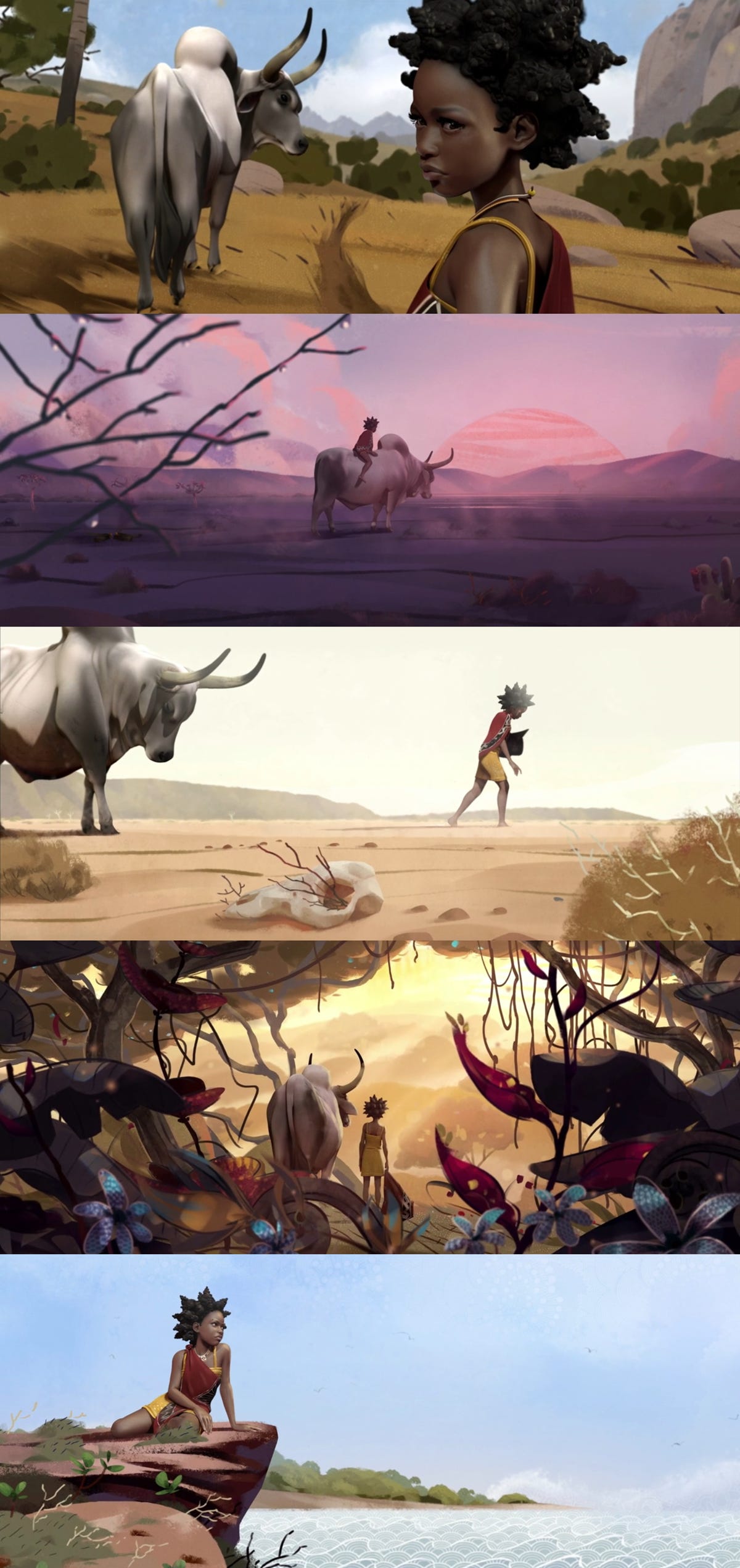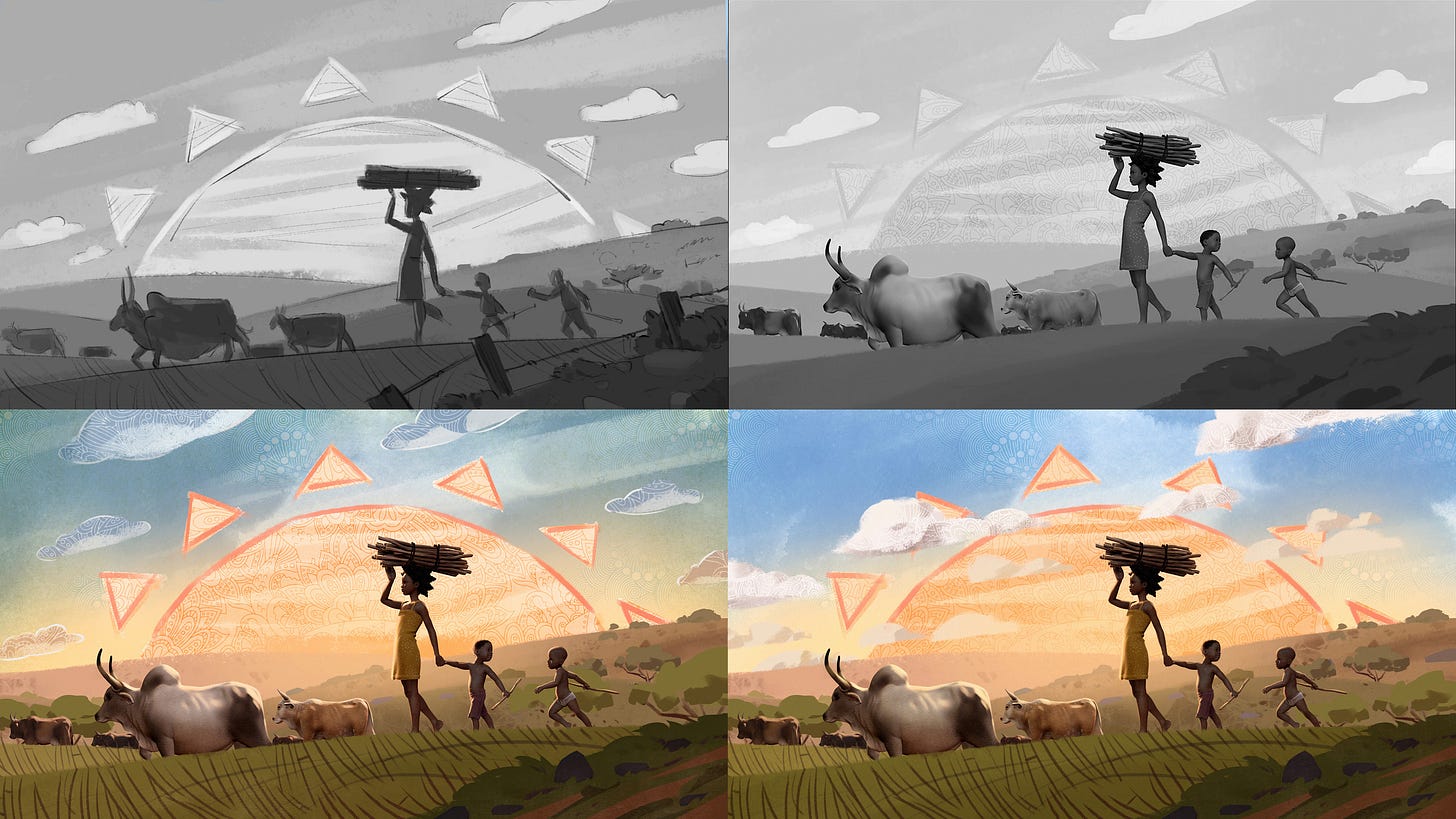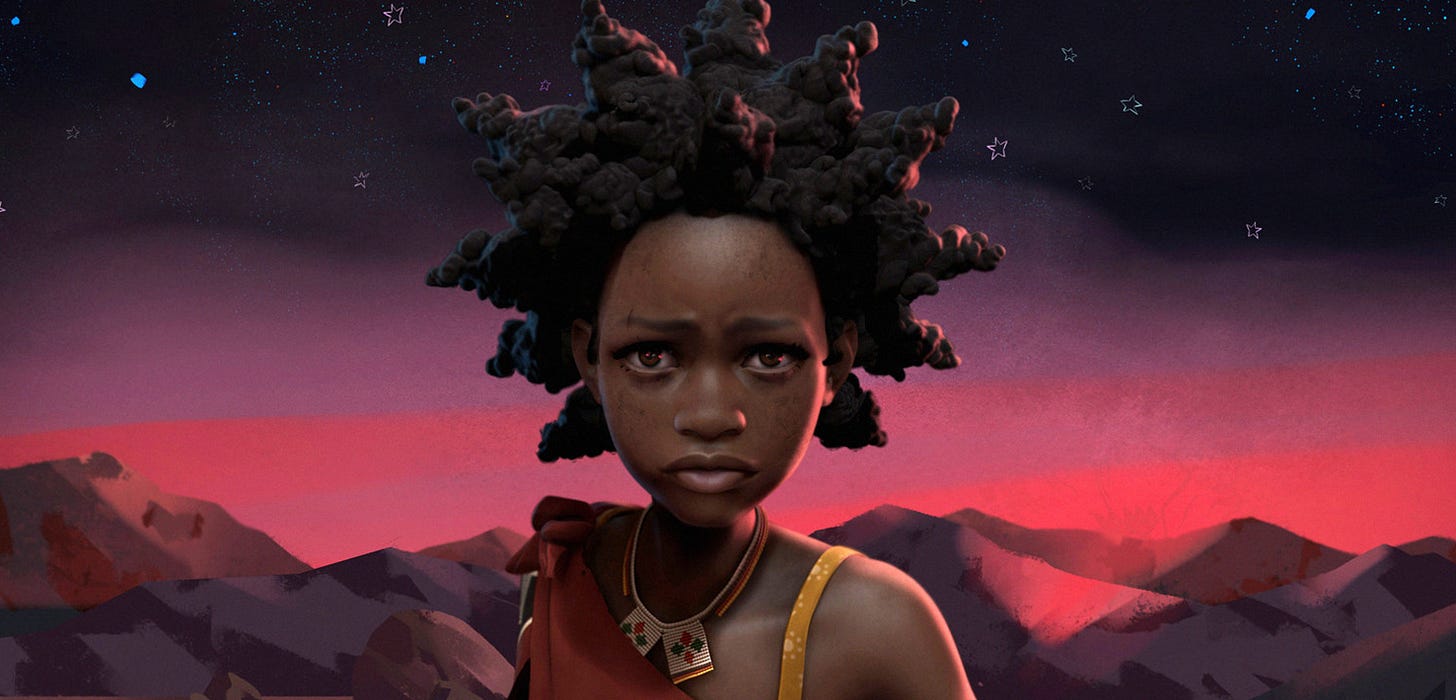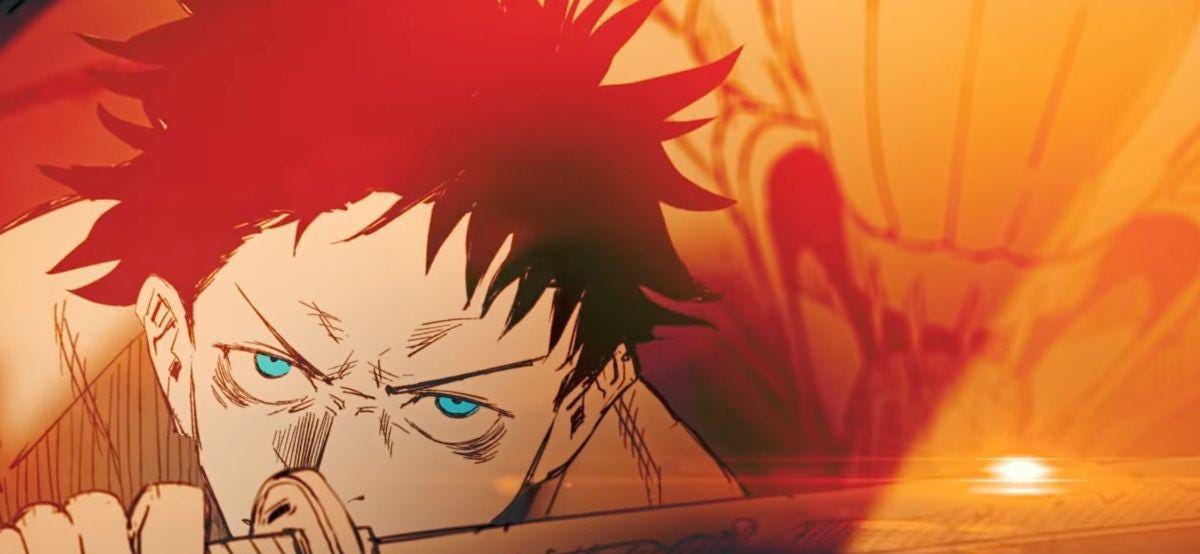Breathing Paintings
Plus: global animation news and more underrated animation.
Welcome! We’re back with another issue of the Animation Obsessive newsletter. For those just joining us, we cover animation from around the world. Here’s the slate today:
One — a look at the “breathing paintings” that animate Liyana.
Two — news about animation from across the globe.
Three — your picks for the year’s underrated animation.
Four — the last word.
We publish every Thursday and Sunday. If you’re new here, signing up for free lets you catch our Sunday issues each week, right in your inbox. It takes zero effort:
Now, here we go!
1. Liyana’s motionless motion
Animated documentaries are on a winning streak lately. One of this year’s top Oscar contenders is Flee — which animates the story of a gay man who escaped Afghanistan as a child. It’s just the newest in a series of animated-doc highlights. Another in that series is the 2017 film Liyana.
Liyana is about orphaned children in Eswatini (Swaziland). The directors, Aaron and Amanda Kopp, had a close connection with the orphanage and wanted to tell the kids’ story. They took a unique approach from the outset. “There’s been a long history of ‘poverty porn,’ ” Aaron told Cinema Escapist, “and we really wanted to intentionally go against that.”
These children had been through hardship, sometimes intense hardship, but the Kopps chose not to center it. Aaron, who was born in Eswatini, said this:
We wanted to reveal the truth [of their lives] in a way that gave them the dignity and respect they deserve, to make a film they’d be proud to watch. We wanted them to [feel comfortable watching] in a room full of their peers and think that this movie they made was cool.
So, they wouldn’t document the children’s trauma directly. “In pre-production I spent time reading about creative art therapies as well as traditional stories in Swaziland,” Aaron said. The idea arose to film the kids as they invented a character and story. This would open “a unique window into their memories and emotions, while still ensuring some privacy.”
The Kopps reached out to a famous South African storyteller, Gcina Mhlophe, to supervise the kids’ story sessions. One Kickstarter campaign later, and they were off. Liyana would become a beautiful hybrid: part documentary, part fiction.
It’s also part live-action and part animation — and the animated scenes are lush, gorgeous and original. They also don’t really move that much. Hiring the Nigerian artist Shofela Coker, the Kopps spearheaded something new. They wanted to create “breathing paintings.”
The breathing paintings are the centerpiece of Liyana — they’re where the children’s tale comes to life. As the young narrators recount the adventures of their hero, Liyana, we see her magical and sometimes dark world conjured up by Coker and his art team. Using animation for this job only made sense. As Aaron put it:
I think pretty early on we had some notion that animation would be a way for us to meet the kids in this fictional world of dreams that they created. As a way for us to reflect back that world of imagination to them, and hopefully bring our skillset to bear — our resources, our privilege — to help them sing that song. […] Animation is, you know, it’s limitless. You can do anything. And so we knew that we could follow them wherever they went.
Finding the right artist took years. Eventually, Amanda spotted Coker online and was captured by his art — and his desire to tell positive stories about Africa. She said that they flew to meet him in San Diego, where he lived, and immediately clicked.
The Kopps showed Coker an early cut of Liyana — they’d already started carving the kids’ hours of storytelling into a concrete narrative. “I was so excited about the project that I did a rough sculpt of Liyana,” Coker remembered, basing it on a photo of a girl at the orphanage. It wowed the Kopps. This initial design mostly stuck.
As they began to collaborate in earnest, Coker and the Kopps settled on a visual style for the animation. Liyana’s breathing paintings would mix 3D characters with 2D environments. This came about partly thanks to the low budget and mostly thanks to creative necessity. The art had to match the children’s story.
“The kids describe the characters in their tale in a very realistic manner,” the team wrote. In response, the characters were rendered in realistic 3D. Yet the world itself is “quite impressionistic” in the kids’ telling. So, the team painted the backgrounds in a somewhat “lyrical and surreal” 2D style.
The animation of it all is minimal — slight movements, a few effects, focus changes, lighting, subtle zooms. Creative necessity dictated this, too. Amanda remarked that “the kids are so emotive and enthusiastic as they describe the story that to have the 3D character also play off the action was a little bit repetitive.”
Instead, the images sit there, moving just enough to breathe but not enough to distract. They’re motionless but alive. The result is mesmerizing.

In the finished product, all of this looks effortless. But there was nothing easy, or obvious, about getting these pieces to mesh with each other or with the live-action footage. Each breathing painting is a feat of both filmmaking and design.
For one thing, the 3D characters and 2D backdrops clashed at first. The final paintings look polished because the team designed with that clash in mind, using collage as a reference point. Even though the characters seem to pop out of the backdrops, that was the point, and Coker tailored it just so. As he recalled:
Very early on, we had talks about trying to create a look in the film that borrowed ideas from very well-known collage artists like Romare Bearden, for instance, and specifically African artists like Njideka Akunyili Crosby. And the idea of using collage as a visual reference to develop the style of the film also tied in with the fact that these animation images had to also rhyme with the live-action.
Coker and Amanda art directed Liyana, using a range of little cues to make the paintings work. That included subtle matching and contrast of “shape, color design, collage elements of patterns and Swazi fabric.”
They used color design not just to tie the 2D and 3D together, but to tie the breathing paintings into the live-action footage. “For every scene in the animated world,” the team wrote, “we color-corrected the corresponding doc interviews to speak to the lighting of the animated scene.” It’s not something you notice in the final film, and that’s why it works. Liyana flows seamlessly between live-action and animation.
Composition played a role here as well. The team built most of the paintings in black and white before adding color — to ensure that the underlying structure held up. In their motionless style of motion, there wasn’t room to be sloppy. Coker said that the characters were “sculpted and posed in each shot to represent the clearest silhouette and action.”
Those clear silhouettes and actions played off camerawork designed to match the style of the live-action footage — “as if it were shot by us with a real camera in physical space,” the team wrote. The paintings are fantasy, but they’re grounded in reality.
By all accounts, Liyana should look low-budget — the filmmakers themselves called their money “very limited.” Besides the Kickstarter, it was funded by grants from National Geographic and other sources. Yet they never let the budget show. Every part of the production, and especially Coker’s art, is built to scale. It does what it can do, and not what it can’t.

Coker’s job on Liyana was crushing — the art team was tiny, and he did the bulk of it. Aaron said that Coker dedicated “a frightening number of hours” to the paintings. In early 2016, around two years after starting, Coker wrote this on his blog:
My work on Liyana is winding down […] It’s a surreal feeling to reach this point on what has been the most creatively fulfilling project I’ve worked on. It was equal parts challenging and rewarding and worthwhile in ways that I haven’t processed yet. The team and I have high hopes for the story’s outreach, but personally, right now I feel a deep sense of relief and pride for doing something so worthwhile with my career.
The Kopps felt that only Coker could’ve pulled it off. It was his passion for the project, his talent for both 2D and 3D art (he’d taught himself the latter) and the fact that he’d grown up in Nigeria. In the mountain of reference material they sent him, he was able to pick out the parts that were specifically Swazi.
“I think if we had worked with someone who wasn’t African it would have been easy for them to slip into a generic, stereotypical ‘African aesthetic,’ ” Aaron said. “We wanted to create a film in which the Swazi people could see their beauty reflected.”
And, when the kids finally saw the finished product in 2017, that’s what happened. They were older — years had passed since the shoot. But they were amazed by what they’d co-created. As the film won awards and its star rose, hitting 98% on Rotten Tomatoes, it also boosted the Liyana Education Fund. This helped to put them through school.
Since wrapping up his work on the breathing paintings, Coker has continued to shine. Next month, he’s dropping the first issue of his Image Comics series New Masters. And he’s a director at the South African animation studio Triggerfish — working on a film called Moremi, part of Disney’s upcoming Kizazi Moto: Generation Fire.
As for Liyana itself, it’s streaming on Tubi for free right now. We recommend it — not just as an important documentary, but as a case study in how to animate without animating.
2. News around the world
Big moves in anime
Just over a week into 2022, the anime world is already awash with major news stories. One is the ongoing success of Jujutsu Kaisen 0. It had the second-biggest opening ever in Japan, beating a record held by Frozen II. Then, after 15 days, it totaled around $58 million in Japan — putting it ahead of Evangelion 3.0+1.0 over the same period.
Jujutsu Kaisen 0 isn’t doing Demon Slayer the Movie numbers, but it’s closer than most. Given that Demon Slayer was the biggest film in Japanese history, that’s impressive — and it shows that anime isn’t slowing down as a business.
Everyone sees that there’s more money to be made here. This week, TBS (Tokyo Broadcasting System) put 2.5 billion yen into its subsidiary Seven Arcs, which recently produced the anime series Blue Period. Expect other big companies to follow TBS’s lead with their own projects.
Meanwhile, in America, this week brought a run on anime streaming services. The company that owns HIDIVE, which is the successor to Anime Network Online, sold to AMC Networks. This is part of AMC’s “niche streaming strategy,” according to Deadline — its portfolio already includes Sundance Now, Acorn TV and Shudder.
AMC isn’t the only company in the market for lesser-known streaming services. RetroCrush got picked up, too — Cinedigm is buying the platform’s parent company, Digital Media Rights. “With the addition of DMR’s channels following the acquisition,” Anime News Network reports, “Cinedigm will have 15 wholly-owned streaming services.”
This is just the latest buyout in anime streaming. Last year, Sony purchased Crunchyroll and merged it with Funimation. At the time, Wired declared that the “era of Big Anime is officially here.”
Best of the rest
Turning Red is missing theaters. Whether Disney keeps investing in Pixar-level budgets without ticket sales remains to be seen — after all, Wish Dragon was a streaming blockbuster on only $25 million, and Squid Game cost $21.4 million.
The Swiss legend Georges Schwizgebel has released a new short animation, The Battle of San Romano, for free on Vimeo.
This week, the world celebrated the 81st birthday of Japanese director Hayao Miyazaki.
The American film Encanto was the biggest animated hit of 2021, in no small part thanks to its songs. So why didn’t Disney submit that one about Bruno for Oscar consideration? Variety has the story.
The ambitious project Otomo: The Complete Works will start appearing in Japan on January 21, with new installments through November. It collects the manga of Katsuhiro Otomo — and his storyboards for Akira.
In Kosovo, the Anibar International Film Festival is looking for entries.
Animation Nights New York interviewed the Chinese animator Jie Weng about The Peony Pavilion, his visually spellbinding stop-motion short. See the film on YouTube.
Japan has a reputation for cracking down on anime and manga piracy. Now, it’s extending its reach through the International Anti-Piracy Organization, working with partners in America, China, South Korea and beyond.
We lost two important figures in Russian animation. One was writer Alexander Timofeyevsky (88) — a Soyuzmultfilm veteran from the likes of Cheburashka. The other was Galina Voropai (49), known for more recent projects like Moonzy.
Lastly, if you work in animation, you’re now eligible to stream the documentary Flee for free via The Animation Showcase.
3. Hidden gems, redux
Last week, as part of our round-up of the most underrated animation of 2021, we asked for your picks via email and Twitter. A number of folks echoed our selection of City of Ghosts — which was fun to see. The series didn’t get much notice when it dropped last year, but it’s slowly built a cult following.
You also named films and series that didn’t make our list, though. We’re looking at them today.
First, there were a few adult comedy picks. The Egyptian cartoonist Sherif B. Adel chose Close Enough, which had its second season and TV premiere last year. He wrote:
Close Enough doesn’t get the attention it deserves. Really funny show with a similar sense of humor to Regular Show. Enjoyed the 2nd season quite a bit!
Another commenter picked the Italian series Tear Along the Dotted Line. A comic artist under the pseudonym Zerocalcare created, wrote and directed it — and voiced nearly the whole cast. It’s semi-autobiographical.
Tear Along the Dotted Line seems to have flown under the radar in America, but we binged it after this suggestion and came away impressed. This show pushes its visuals in a way that adult animated comedies often don’t. Transitions, location changes, new assets, complex animation and unusual camera angles whiz by.
That said, what carries it is Zerocalcare’s writing — which is funny and incisive, but also surprisingly emotional. He dissects his (many) own neuroses at a rapid pace. If that sounds like your thing, the series is on Netflix in English.
Lastly, we have The White Moon from Wolf Smoke Studio, based in Shanghai. Longtime reader Awayfarer called it a “beautiful continuation of Chinese ink painting animation.” The technical finesse here is hard to deny. You’ll find the film for free on YouTube — it’s just eight minutes long but hasn’t even attracted 10,000 views yet.
Thanks to everyone for participating! We want to do this more often — asking what animation you’ve been watching and wanting to recommend, even if it’s only a minute or a few seconds long. Something fun and low-pressure, maybe once a month. Let us know if that sounds interesting, and if there’s another animated project you’d like to highlight!
4. Last word
And that’s the end! Thanks for reading — we hope you’ve enjoyed this week’s Sunday edition. You can keep an eye out for our next issue on Thursday.
If you missed our previous issue, it covers the wild history of Mongolian animation. Among other things, we zero in on the career of artist Myagmar Sodnompil, who helped to pioneer animation in Mongolia. We also dive into the country’s broader history, how animation started and survived there — and why Genghis Khan was once taboo in cartoons. Hope you’ll check it out!
See you again soon!





Dope. Yeah, big fan of animation in documentaries, or stand alone animated documentaries. As a person making one, I am biased, but gosh darn, using animation to bring real people/stories to life is fun. And, incredibly challenging. Thanks for all this insight on shorts and series to watch. Got my weekly cue lined-up now! Mahalos!